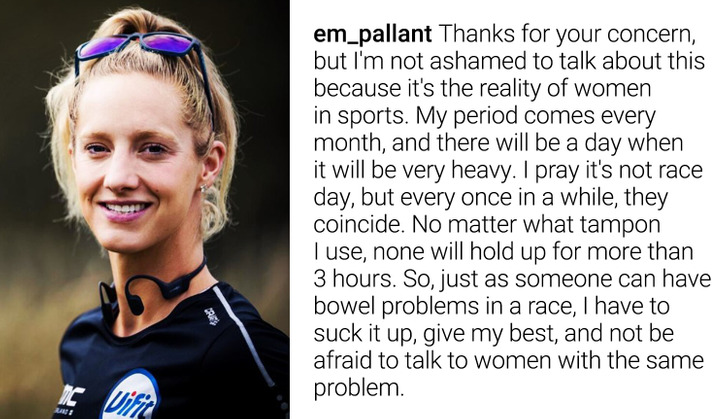“Not the most flattering photo of Emma, surely they can crop it a little better,” commented Xavier Coppock on a post where the athlete is shown finishing a race with a bloodstained one-piece swimsuit. It was at that precise moment that a long debate ensued.
Emma Pallant-Browne is a British athlete who competes in triathlon, duathlon, and aquathlon events. Among her latest achievements, she won a silver medal at the 2022 World Long Distance Triathlon Championships. In the prestigious Ironman 70.3 competition, she won 2 medals (silver in 2017 and bronze in 2022) and a gold medal at the European Championship in the same year.
In her latest multi-sport challenge, Emma finished fourth. The PTO Tour European Open in Ibiza was held just days after she won the Duathlon World Championship.
On the other hand, Xavier Coppock is another triathlete who decided to comment on a photo of Emma that had been published on the official profile of the competition that took place in Spain. Among the images, she is shown running with a red stain on her swimsuit due to her period.
Although we believe that the athlete’s comment was not made with ill intentions, his words caused a stir online. For her part, Emma was quick to respond. In the same forum, she tagged him and dedicated a few lines to him.

5 days later, the athlete uploaded the same photo to her profile. In the description, she sent an important message. “Celebrating the amazing women in sport and the equally amazing men who champion them. Humbled by the number of messages I’ve had from both men and women about the unglamorous reality of racing on your period,” she began.
In the post, she explained the factors that contributed to this situation. Her light pink outfit was chosen so as not to attract the sun’s rays, and she rolled over her bike, making the stain more visible. She squirted water at the hydration stations, but it failed to remove the stain.
“This is a women’s sport and the more barriers we can break, the better. After a long career, you end up with a photo like this, but the idea of editing it means there is something wrong with it. I share it because there’s really nothing wrong with it, it’s a natural thing,” she said.
“So if you have a photo like this, save it, cherish it, and remember how you performed on a tough day because one day you might just be able to help someone else with it,” she concluded in her powerful message.

The original post was deleted, but we still have Emma’s, which she posted on her profile. This athlete gave us a lot to talk about — she managed to turn a small comment into an empowering message regarding menstruation. It gave us pause and made us think about the natural things we should stop turning into taboos.
Preview photo credit em_pallant / Instagram, professionaltriathletesorg / Instagram
Former President Jimmy Carter’s Modest Lifestyle: A Reflection of His Values

James Earl Carter Jr. was raised in a loving home by his mother, a devoted nurse, and father, a prosperous businessman, after being born in the small Georgian town of Plains. His desire of serving in the military was realized at the Naval Academy, where his early education culminated.

Jimmy Carter’s life turned around in 1946 when he wed his academy sweetheart, leading to a happy family life. Choosing not to pursue a career in the Navy, he came back to Plains to take over the family business and construct a modest ranch-style home that is currently worth slightly more than $209,996. This decision demonstrated his willingness to live a modest life and forgo the financial rewards that his predecessors in office usually sought.

Unlike other past presidents like Barack Obama, Bill Clinton, and George W. Bush, who racked up millions of dollars in spending, Jimmy Carter’s post-presidential years were characterized by thrift and public service. His modest yearly taxpayer-funded expenses were significantly lower, at $456,000.

Surprisingly, Carter is frequently spotted at his neighborhood Dollar General, opting for commercial travel over private, and imparting his wisdom in Sunday school and college classrooms. His modest, grounded way of living says a lot about his morals and the satisfaction he derives from minimalism.



Leave a Reply